DIamond Clarity
Clarity – The degree to which a diamond is free from natural phenomena known as inclusions: Inclusions are natural imperfections, traces of the pressure and processes involved in their formation and often referred to as ‘nature’s fingerprints’. They are nature’s birthmarks. Diamond crystals form within a mother rock known as Kimberlite, this rock consists of a varied mixture of many different minerals, some of the more common minerals found in a Diamond, as inclusions, are the gemstones known as Garnet (Red), Olivine (Olive Green/Brown) and Peridot (Lime Green). Occasionally the green gemstone Diopside is present. Very rarely are the colour of these gemstone inclusions visible, they usually appear black because the inclusion acts as a black hole by absorbing light.
Most diamonds have tiny crystals of these minerals imbedded in them, trapped as the Diamond crystal was forming, they may look like tiny crystals, clouds, or feathers. Sometimes small diamond crystals may themselves be trapped in the formation of a larger Diamond crystal, when this happens, a Knot is formed inside the host Diamond crystal; These Knots make the cutting and polishing very problematic. In the higher grades of Diamond clarity VVs1 down to Vs1 the greater majority of these inclusions cannot be seen by the human eye, being the size of dust particles, they can only be seen under magnification. The universal magnification for all Diamond grading is carried out using a 10x magnification Diamond Loupe.
Clarity and Value
The cleaner Purer a Diamond, the More Brilliant. The greater a diamond’s clarity, the more brilliant, valuable and rare it is. Virtually all natural diamonds contain identifying characteristics, yet many are invisible to the naked eye. Under the scrutiny of a jeweller’s 10x-magnifying loupe or microscope, these natural phenomena — called inclusions — may be seen. Diamonds categorized as internally flawless reveal no such inclusions. Flawless stones are the finest and are treasured for their rarity and beauty. Diamonds with very, very small inclusions are graded as VVS1 or VVS2. The larger the inclusion, the lower the grade and the less rare the diamond. Inclusions that can usually be seen with the naked eye are graded I1 or I3. The number, colour, type, size and position of surface and internal birthmarks affect a diamond’s value. Major inclusions can interfere with the path of light that travels through a diamond, diminishing its brilliance and sparkle and therefore its value.

Diamond – Clarity Grading Chart
| General Description | GIA/EGL | JC/HRD | Explanation |
|---|---|---|---|
| No internal imperfection visible to a trained eye under 10X magnification |
1F | LC | Internally Flawless / Loupe Clean |
| Minute inclusions that are extremely difficult to detect under 10X magnification |
VVS1 VVS2 |
VVS1 VVS2 |
Very slightly included |
| Very small inclusions which are difficult to see under 10X magnification |
VS1 VS2 |
VS1 VS2 |
Very slightly included |
| Small inclusions fairly easy to see under 10X magnification, but not visible to the unaided eye |
S11 S12 |
S11 S12 |
Slightly included |
| Visible with difficulty to the unaided eye | 11 | 11 / P1 | Imperfect / Pique 1 |
| Easily visible to the unaided eye | 12 | 12 /P2 | Imperfect / Pique 2 |
| Very easily visible to the unaided eye | 13 | 13 / P3 | Imperfect / Pique 3 |
Different Types of Inclusions
There are basically two categories of inclusions found in natural diamonds. Syngenetic inclusions formed at the same time as the diamond and Epigenetic inclusions formed afterwards. The names and descriptions of the different types of inclusions and blemishes, which affect a diamond’s clarity to varying degrees are detailed below:
Inclusion
Black Spots – Crystalline inclusions inside the diamond.
Cavity – A large or deep opening on the diamond surface.
Cleavage – A straight crack with no feathering.
Cloud – A group of minute white inclusions resulting in a milky or cloudy appearance.
Feather – A separation due to either cleavage or fracture which is often white and feathery in appearance.
Internal graining – Irregular crystal growth which may appear milky, like faint lines or streaks, or may be coloured or reflective.
Knot – An included diamond crystal which reaches the surface of a polished diamond.
Laser Lines – Vapour-like trails left behind when lasers are used to remove dark inclusions from a diamond.
Pinpoints – Minute spots internal to a diamond. A cluster of pinpoints can form a cloud.
Blemishes
Scratches – A fine white line, curved or straight.
Fracture – A crack on the surface of the stone.
Nicks – A chip near the girdle or a facet edge.
Pits – A minute opening resembling a white dot usually triangular in appearance called a Trigon.
Polish lines – Minute lines caused during this process.
Bearding – Stress hair-like lines usually occurring during the cutting of a diamond visible round the girdle.
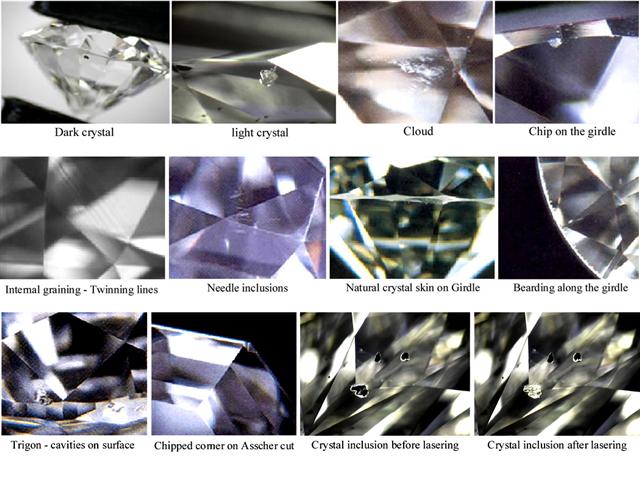
| Clarity Grade | Description | Illustration | Photo |
|---|---|---|---|
| Fl | Flawless – No blemishes or inclusions. | 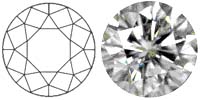 |
Enlarge FL |
| IF | Internally Flawless – No inclusions. Insignificant blemishes. | 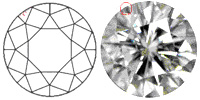 |
Enlarge IF |
| VVS1, VVS2 | Very, Very Slightly Included: Very difficult to see inclusions under 10x magnification. | 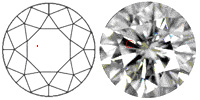 |
Enlarge Vvs1 Enlarge Vvs2 |
| VS1, VS2 | Very Slightly Included: Minor inclusions are not visible to the unaided eye. Less expensive than the VVS1 or VVS2 grades. | 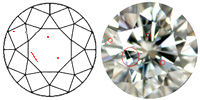 |
Enlarge Vs1 Enlarge Vs2 |
| SI1, SI2 | Slightly Included: Inclusions are visible under 10x magnification but not easily visible to the naked eye. | 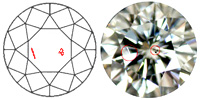 |
Enlarge Si1 Enlarge Si2 |
| Pique 1 | Alternatively – Slightly Included: SI3 this is an EGL (European Gemological Laboratory) grade and is not reported by GIA (Gemological Institute of America) or (American Gemological Society). Inclusions are visible under 10x magnification and barely visible to the naked eye. |   |
Enlarge P1 |
| Pique 2 | Included: Inclusions are obvious at 10x magnification, but in small brilliant-cut diamonds they are barely visible through the crown to the unaided eye. Good choice for people on a limited budget. |  |
Enlarge P2 |
| Pique 3 | Included: Inclusions are easily visible to the naked eye. Often used in discount jewellery. | 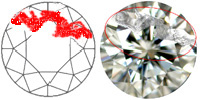 |
Enlarge P3 |

